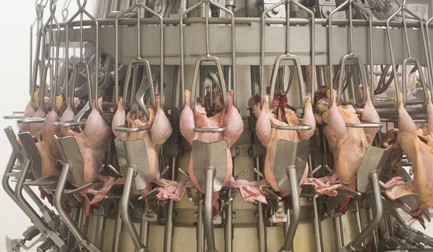Information
Giblets are a valuable source of revenue. Harvesting them effectively and efficiently is most definitely in the processor’s best interest.
In many processing plants around the world with manual or automated evisceration, giblet processing is done by hand. The manual operations to remove inedible offal and harvest edible giblets require specialized hand tools, such as knives, scissors and shears. Absolute precondition for hygienic manual giblet harvesting is an overhead conveyor line, such as Marel Sigma. A conveyor line prevents products from touching one another and presents the products evenly distributed at a constant speed.
Evisceration stage
Before entering the giblet processing department, the products have been eviscerated. A usual procedure is to remove the viscera pack manually or mechanically from the bird and hang it over its back. In case of a Nuova eviscerator, the viscera pack will be offered to the operators hanging from a separate pack shackle. This opens the way for easy hygienic manual harvesting of giblets.
Risk material
When collecting organs manually, the risk material is first separated from that with value. Therefore, the gall bladder and intestines need to be removed manually with utmost care. All damage must be prevented, for their contents shouldn’t come into contact with the edible giblets, which would risk contamination. Gall bladder removal is particularly important, because bile on the carcass makes the meat worthless. If the gall bladder breaks inside the bird, the bitter green fluid will quickly run out and contaminate the meat. Intestine removal should happen without letting fecal material escape and contaminate the bird.
Giblet harvesting
The first giblets to be removed from the top of the viscera pack are the heart and lungs. Theyneed to be separated manually from each other. Next, the pericardium and any loose tendons or arteries should be removed from the heart. Chicken hearts are more common for human consumption, but in several markets lungs are eaten too. So both giblet types should be treated hygienically and carefully.
Then the liver is gently removed from the viscera pack too, by separating it from the surrounding fat. The liver can be subject to more manual trimming, if needed, after this separation.
Finally, the gizzard is cut loose from the intestines. A useful tool for this is the bent gizzard trimmer, enabling the gizzard to be easily separated from the intestines and opened. The operator detaches the gizzard muscle (the stomach to grind food) manually from the pack, slits it open, removes the contents, rinses it and peels off the strong yellow inner membrane. Then the gizzard is washed and its fat is removed if necessary.
All edible giblets, gizzards, hearts and livers should be inspected, washed and chilled in order to extend their shelf life. Unused materials of the viscera pack can go into the rendering process or can be processed for pet food production.






